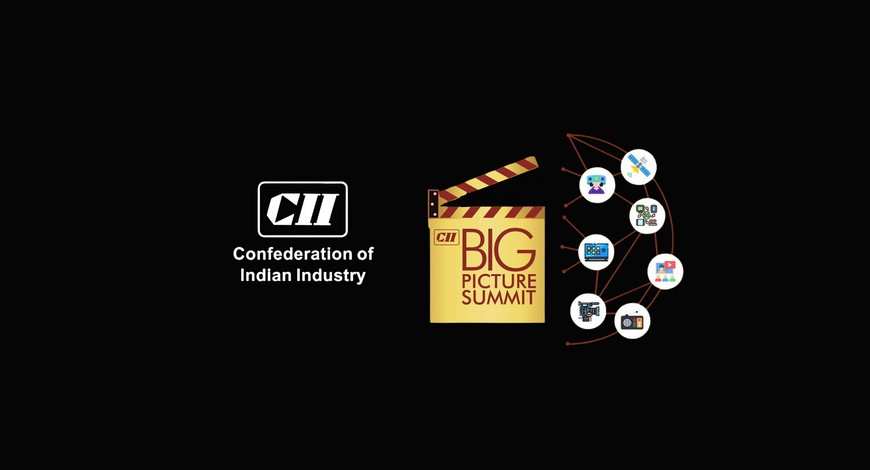BCS Stories
CII Summit-A review

The 11th edition of the “Big Picture Summit 2022” was organised by Confederation of Indian Industry (CII) in New Delhi on November 16 -17.
The Summit, with a range of sessions, has participation from content creators, broadcasters, buyers, studios, production companies, publishers, distributors and developers across the gamut of the Media & Entertainment landscape. The Summit also witnessed the participation of other eminent panellists and marked the release of the CII-BCG Report on “Shaping the Future of Indian M&E” and the CII-IBDF-KPMG report on “Sports Broadcasting in India”.
On Day One, discussions centred around global trends and opportunities; bounce-back of revenues to pre-pandemic levels; domestic consumer preferences and local opportunities for global audience through digital platforms which have never existed before – especially for creative industry, storytellers, and technology providers.
K Madhavan, Chairman, CII National Committee on Media & Entertainment and Country Manager & President Disney Star in his opening remarks commended CII for bringing together key stakeholders and policy makers together to discuss the future of India’s M&E industry and its potential in shaping societies. The M&E sector in India is underpenetrated, with a contribution of 0.9 percent to the GDP compared to 3-4 percent for many developed countries. He further advocated the potential of growth for the industry, owing to the presence of 300 million households in India of which about 100 mn households still have no access to television headsets. He further urged for timely support by policy makers in the areas of privacy, ensuring a supportive IPR protection measure and announcing content related policies while taking note of the changing consumer habits and helping the industry to reinvent and adapt to creating travelable content.
Apurva Chandra, Secretary, Ministry of Information and Broadcasting, stated that the Ministry of Information and Broadcasting, along with the Indian Media and Entertainment industry, has set a goal of making the M&E sector a $100bn worth industry by 2030. Chandra acknowledged the announcement by the ministry on the incentive policy for cinema at the Cannes Film Festival this year, out of which, many proposals have been accepted for foreign productions in India. He further revealed that “the AVGC taskforce, which was launched as a part of the Union Budget 2022, has completed its deliberations and is in the process of finalisation. The government will soon work toward actioning on the recommendations that come out of the report.” As regards the broadcasting sector, Chandra stated that the Ministry has recently revised the guidelines for Uplinking and Downlinking for satellite television channels in India to ease the burden of compliance on channels.
P.D. Vaghela, Chairman, Telecom Regulatory Authority of India (TRAI), highlighted the significance of the Indian M&E sector in the national growth story and economic prosperity. With about half of the population being young, the Indian demographic dividend presents a huge opportunity for Indian M&E services. Television is the largest and the fastest growing segment, representing around 50 percent of the total media and entertainment revenue. He added that during the last decade, the M&E sector in the country has undergone several radical changes and is experiencing a paradigm shift due to advancement of technologies and innovations in the creation, distribution, and consumption of media. He stressed that the traditional media would lose its ground unless it understands, adopts, and merges its own business models with society 5.0, AI, machine learning and other technologies that are being unleased. Dr Vaghela further mentioned that “the government needs to come out with policies that are flexible in nature and allows new players to easily enter the industry while at the same time must not strangulate the traditional sector with numerous regulations.”
Sanjiv Shankar, Joint Secretary, Ministry of Information & Broadcasting, referred to the various efforts made by the ministry in the recent past to ensure significant interventions in the regulatory framework, largely based on ease of doing business, Atmanirbhar Bharat and Make in India. He stressed on the Broadcast Seva portal, which offers a single point facility to various stakeholders and applicants to apply for various permissions, registrations, licenses etc., for the development and integration of the broadcast industry.
Anil Bharadwaj, Advisor, Telecom Regulatory Authority of India (TRAI), said that while TRAI is trying to enable a positive, consultative-based, industry-friendly approach with regards to NTO, the industry needs to focus on building capacities and centers of excellence.
Biren Ghose, Vice Chairman – CII National Committee on Media & Entertainment Chair – CII Sub Committee for AVGC & Immersive Media, Country Head – Technicolor India, in his closing remarks mentioned the need to evolve in the ways content is being created and urged the stakeholders to look at growth from a different lens, particularly away from a linear vertical growth. Moreover, he mentioned about fostering collaboration between government, industry, and academia for continued growth of the M&E sector.
CII has been driving several initiatives to take the Indian M&E sector to new heights and expand its global footprint in close collaboration with the Ministry of Information & Broadcasting. These include representing the Indian film and entertainment industry at the prestigious Cannes Film Market for the past 20 years; at Berlin Film Festival for the past 5 years and the Toronto Film Festival for the past 3 years. CII’s strength in policy advocacy is acknowledged and accepted by both government and media industry.





